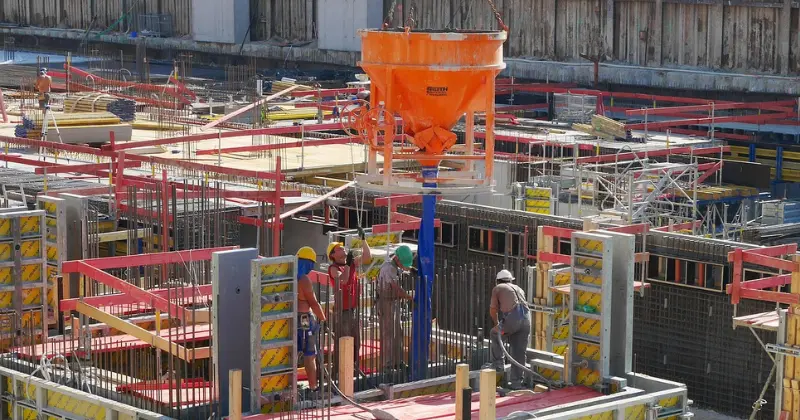11 mins read
Building Smarter: The Strategic Power of Value Engineering in Construction

- What Is Value Engineering in Construction?
- When Should Value Engineering Take Place?
- Value Engineering Examples in Construction
- Roles and Responsibilities in Construction Value Engineering
- The Importance of Value Engineering in Construction Projects
- Value Engineering Techniques in Construction
- Conclusion
Value engineering is one of the ideas that has been transforming the building sector in the last few decades. This approach guarantees that every dollar you spend will yield the most benefit since it offers a methodical approach to checking and enhancing building activities.
Construction value engineering can identify ways to save money, increase efficiency, and maintain or even raise quality by dissecting a project into its component parts. Whether it is being managed, designed, or contracted for, your knowledge and application of value engineering ideas will greatly influence the financial gain and success of it.
Let’s explore the broad ideas of value engineering, its significance, and how to best apply it in building endeavors.
What Is Value Engineering in Construction?
Construction value engineering is used to optimize all the different functions of a project with the aim of completing it at a lower cost without compromising on quality. This includes analyzing the design, materials, construction techniques, and operational procedures.
The origin of value engineering can be traced back to a person named Lawrence Miles. During World War II – when the manufacturing industry was at its peak – he was responsible for purchasing raw materials for General Electric. Because the war caused extreme material shortages, Miles started to search for suitable alternatives that functioned similarly. His search led him to discover that some material substitutes were not only cost-effective, but actually better. This was the start of “value analysis” (more commonly known today as value engineering).
Since its inception, value engineering has been embraced extensively in many sectors. Value engineering helps to find and remove undesired expenses and raise function and quality. Seeking the best possible value for the lowest cost, the set of disciplined steps in the value engineering process is supposed to maximize initial and long-term investment.
When Should Value Engineering Take Place?
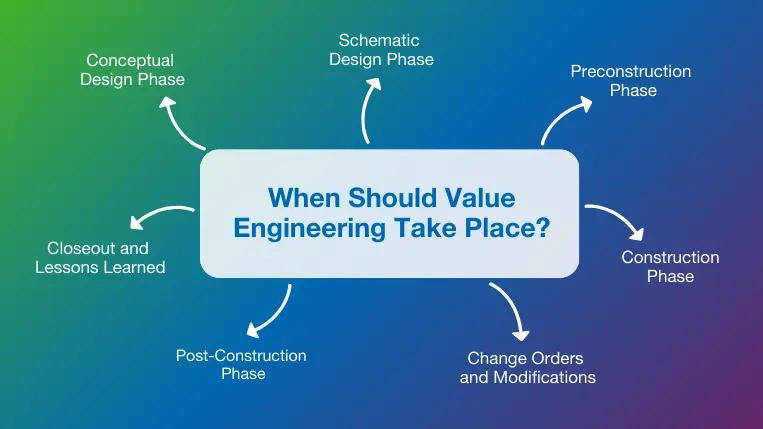
The timing of value engineering efforts plays an important role in their effectiveness. As a building professional, you will save a lot of money, increase construction productivity, and improve your project’s results if you apply value engineering at the right stages in your project.
1. Conceptual Design Phase
The best time to incorporate value engineering is when you’re still in the conceptual design stage. During this stage, the team experiments with different designs and makes adjustments without worrying too much about the budget. If your client’s budget and performance goals are well defined early on, value engineering will help find ways to save money, improve the design, and keep everything on track.
2. Schematic Design Phase
The goal of the schematic design stage is to flesh out the rough ideas for the design into a more comprehensive blueprint. During this phase, value engineering makes it possible for the team to streamline procedures, use cost-effective materials, and enhance any design decisions they make. To avoid expensive revisions later on, it is important to identify possible problems and alternate solutions at an early stage.
3. Preconstruction Phase
- Detailed Design and Engineering
During preconstruction planning, detailed engineering and design plans are created. At this stage, value engineers concentrate on making sure that the design details, material specifications, and building procedures are finalized. The team may ensure that the solutions they choose offer the most value for money by carefully examining the project’s functions and costs. You can gain practical insights into the cost-effectiveness and feasibility of proposed changes by engaging important stakeholders, such as suppliers and contractors.
- Contracting and Procurement
During the contracting and construction procurement stages, value engineering allows the team to choose suppliers and contractors that provide the best performance, cost, and quality value. Value engineering can also aid in finding more cost-saving opportunities and negotiating more favorable conditions.
4. Construction Phase
Although value engineering is most effective when applied early on in a project, it can still prove useful during the building phase. Using value engineering to provide cost-effective solutions and optimize ongoing operations, you can face unexpected challenges head-on. Project success depends on being on schedule and under budget, which may be achieved by constant monitoring and value engineering efforts.
5. Change Orders and Modifications
Value engineering in the construction industry can provide a structured approach to evaluating its impact on the project. By analyzing the costs and benefits of proposed changes, the team can make informed decisions that maintain value and minimize disruptions.
6. Post-Construction Phase
The post-building phase is very important for gathering knowledge gained and evaluating the success of the endeavor. During this phase, teams assess how well the applied value engineering solutions matched the initial goals. Examining cost reductions, efficiency gains, and any realized quality enhancements are part of this.
To find improvement areas, all stakeholders—including end users, clients, and contractors—provide feedback. This phase also usually includes a last audit to verify that all value engineering modifications satisfy and possibly exceed the project’s needs.
7. Closeout and Lessons Learned
Although value engineering is typically associated with the earlier stages of a project, it can also provide valuable insights during the closeout phase. Project managers can gauge what worked and what didn’t by looking back at the results. Value engineering in future building endeavors can be even more effective with this continual improvement method.
Value Engineering Examples in Construction
Three common examples of value engineering in construction are estimating software, design modification, and material substitution:
- Estimating software
Construction estimating software helps project managers and estimators accurately calculate the materials, labor, and costs associated with building. By providing detailed cost breakdowns and analysis, estimating software can help make more informed decisions about cost reduction, all without affecting project quality.
- Design modification
Simplifying design elements can reduce building complexities and costs. An example could be redesigning a building layout to reduce the amount of cut-and-fill needed on a sloped site, which minimizes earthmoving activities.
- Material substitution
One frequent use of value engineering is material substitution to lower expenses without sacrificing quality. For instance, using modular metal framing instead of custom-fabricated steel can save on both material costs and labor while maintaining structural integrity.
Roles and Responsibilities in Construction Value Engineering
For construction value engineering to be effective, various stakeholders, each with their own set of knowledge and experience, must work together:
- Project Managers
The role of project managers in construction cannot be underestimated, and they are especially crucial in the value engineering process. The value engineering activities must be in sync with the project’s overarching objectives and schedule, which they are tasked with overseeing. Project managers make sure the value engineering process runs well by coordinating everyone’s efforts, facilitating communication, and checking in periodically to make sure everything is on track. Also, they check that the value engineering solutions suggested are viable and fit with the timetable and budget.
- Design Engineers
When it comes to maximizing design, design engineers are quite valuable because of their great technical expertise. Analyzing the design, developing fresh materials or building techniques, and verifying that any changes will enhance or maintain the performance and functionality help them to identify ways to save money. Close cooperation among design engineers with other team members results in original ideas that satisfy requirements.
- Cost Estimators
Cost estimators play a critical role in the construction value engineering process by providing detailed analyses for accurate cost estimation in construction projects. They assist the team in determining the most cost-effective solutions by analyzing the financial implications of several design choices and building methods. Additionally, cost estimators make sure that the quality and performance will not be compromised in any way by the proposed value engineering adjustments; that is, they will lead to cost savings. To make educated decisions on finances, their knowledge is crucial.
- Contractors
The construction value engineering approach benefits from the realistic, on-the-ground viewpoints that contractors provide. They can evaluate the practicality of suggested modifications and throw light on possible implementation obstacles thanks to their extensive hands-on expertise in the building industry. In this way, contractors can find feasible and efficient building methods, propose ways to save costs, and verify that the value engineering solutions are feasible. Their feedback, provided using professional construction collaboration software, is critical for making the transition from abstract value engineering ideas to concrete plans of action.
- Clients
In value engineering, the project’s clients or owners have the last say. Their main duty is to decide whether the suggested value engineering adjustments are in line with the project’s objectives, finances, and quality requirements and, if not, to approve or reject them. The value engineering building is only considered successful if the client is satisfied and gets what they expect. The value engineering team relies on them for crucial support, which they provide by helping to define the project’s scope and objectives.
- Value Engineering Facilitators
Consultants or specialists from outside the organization often act as value engineering facilitators. They guarantee a methodical and productive process by bringing specific knowledge and expertise in value engineering methodologies to the table. Facilitators guide teams through the process of generating ideas for cost-cutting measures, evaluating those ideas, and ensuring that the team stays on track. Their knowledge and experience allow the value engineering process to go as smoothly as possible.
The Importance of Value Engineering in Construction Projects
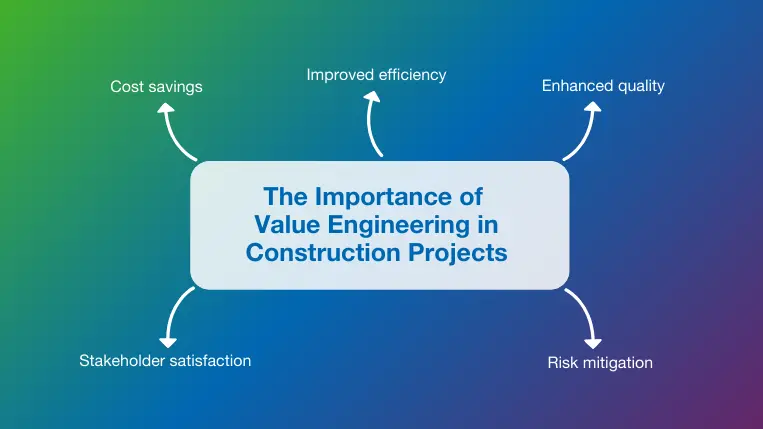
Value engineering in construction has many benefits, including cost savings, improved efficiency, enhanced quality, risk reduction, sustainability, and stakeholder satisfaction:
Cost Savings
Reduced building expenses are among value engineering’s most significant advantages. Value engineering helps in construction cost control by allowing you to methodically search for ways to reduce costs without compromising the design, materials, or building techniques of the project. This helps teams to precisely determine where their resources would be most utilized, so greatly reducing costs. This promotes resources and financial savings that can be applied to other crucial facets of the project.
Improved Efficiency
Value engineering guarantees smooth operations by removing unnecessary and inefficient processes. By optimizing the use of materials, simplifying building procedures, and streamlining work methods, value engineering improves all functions that are to be realized by a project in physical form. This enhanced efficiency should lead to a shorter timeline, lower labor costs, and less wasted money, all resulting in a successful outcome.
Enhanced Quality
Value engineering in the construction industry does so much more than just improve a project’s quality; contrary to popular belief, it is not merely a cost-cutting process. Value engineering can improve the quality of projects by analyzing the many tasks involved and creating a strategy that works best for each task. Using high-quality materials, efficient building methods, and following industry standards, all contribute to value that lasts. This ensures high quality results that benefit all parties involved for many years to come.
Risk Mitigation
Value engineering helps reduce risk and ensure efficient construction risk management, since it addresses potential sources of conflict early on in the project lifecycle. It can not only find weaknesses, but also logical alternatives to fix them by conducting proper evaluation against design philosophies and building methods. With this proactive approach, you can greatly reduce delays, costly rework, and other issues.
In addition, if you include value engineering into the value management process, you will foster a culture of constant improvement: groups are always looking for new ways to reduce risk and putting that knowledge into action.
Stakeholder Satisfaction
When value engineering is done, stakeholders are bound to be more satisfied that the project will meet or even exceed their expectations. Value engineering will build trust among customers and investors by delivering a quality result regarding cost and time. And when customers are happy, they are more likely to use your services again. This in turn increases favorable referrals and leaves a positive impression of your company in the marketplace.
Along with that, it will instill characteristics like open communication and cooperation, which foster a positive work atmosphere among team members and lead to improved outcomes.
Value Engineering Techniques in Construction
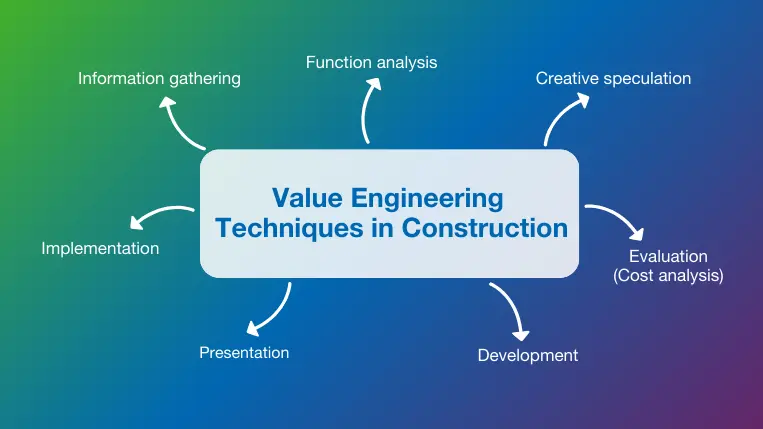
So, how to do value engineering for construction? There are six steps in the value engineering process that enable teams to identify and implement the most effective ideas:
Information Gathering
The first step of the value engineering process is to collect all relevant information about the building assignment. This includes the requirements, timetable, budget, and detailed construction specifications. During this stage, the primary objective is to get a thorough comprehension of the scope and the client’s expectations. Collecting this data is vital since it serves as the basis for all future value engineering decisions.
Function Analysis
Function analysis involves identifying and understanding the essential functions of the building assignment. In this stage, you’ll dissect it into its component parts and establish what each part needs to achieve.
The main point is to differentiate between primary functions, which are necessary for succeeding, and secondary functions, which are nice to have but not necessary. When you have a clear idea of these functions, it will be easier to prioritize activities and allocate resources later on.
Creative Speculation
Once the functions have been clearly defined, the next step is creative speculation. At this stage, you should try to think creatively about how to solve problems to generate new ideas that could increase value while decreasing expenses. The aim is to generate a wide range of ideas, regardless of their initial feasibility, as these will be refined in later stages.
Evaluation (Cost Analysis)
In the evaluation phase, the feasibility of the brainstormed ideas is analyzed. The potential costs and benefits of each alternative are considered in light of its ability to carry out the necessary tasks. To better understand the possible savings that each option may provide, a cost analysis is essential in this case. The best ideas are those that improve functionality while keeping costs the same or lower.
Development
In the development stage, the best ideas that emerged from the evaluation phase are fleshed out into comprehensive plans. Design refinement, in-depth technical and financial analysis, and, if required, the creation of preliminary models or sketches are all part of this process. The development phase aims to transform creative ideas into practical, actionable plans.
Presentation
Once the plans have been developed, the team presents them to all the relevant stakeholders. Clients, project managers, and other influential parties may fall into this category. The presentation needs to effectively communicate the benefits and feasibility of the proposed value engineering changes, highlighting how they will improve the assignment’s overall value. If you want to get the green light to go forward, you need to communicate clearly and persuasively.
Implementation
Implementation is the last step in value engineering. The modifications are incorporated once they have been approved. This phase requires meticulous coordination and management to guarantee a seamless integration of the modifications and their intended functionality. To keep the results under control, it is essential to monitor and make adjustments as needed during implementation. Investing in a professional construction reporting system to monitor the changes in real-time can present a significant competitive advantage, as any issues can be spotted and mitigated immediately.
Conclusion
Value engineering in construction management is one of the strongest tools in the building industry’s arsenal, driving cost savings, efficiency, and quality improvements. By systematically analyzing and optimizing project functions, value engineering ensures that construction endeavors deliver maximum value to stakeholders.
To further enhance your value engineering efforts, consider investing in advanced construction cost management software such as RIB BuildSmart. Our innovative platform, designed by industry experts, helps construction professionals gain full control of revenues and expenditures by automating manual processes, increasing efficiency, and driving financial value. Embrace the future of construction management and get a demo for RIB BuildSmart today!

Most Recent
11 mins read
10 mins read
10 mins read
29 mins read
Blog Categories
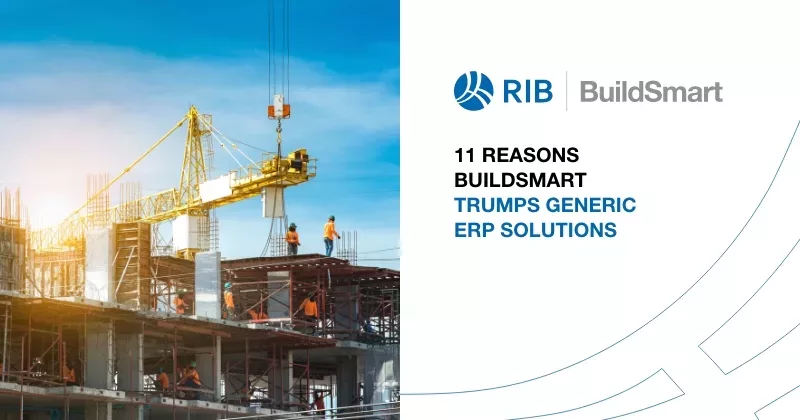
Ebook





